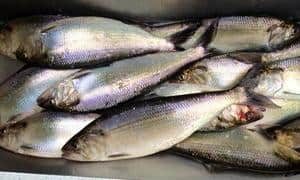As I write this on June 11, 2024, it’s been exactly four years since 455,737 American shad were counted as they crossed Bonneville Dam on the Columbia River in Oregon and Washington.
Nearly a half million fish passing by any fish counter is an incredible number, even for the lowest dam spanning the largest river in the West. But this happened in a single day, and it’s not even all that unusual.
Most years, there are a few days that 200,000, 300,000, or yes, occasionally 400,000 shad pass the public viewing window at Bonneville Dam. The massive structure is roughly 100 miles inland from the Pacific Ocean and about 45 minutes east of Portland, Oregon, or Vancouver, Washington.
I stopped by the dam’s fish windows on June 21 and this is what I saw:

While we haven’t yet seen any single days anywhere near 400,000 this year, which started out cooler than many recent seasons, eight of the past 10 days saw more than 100,000 shad climb the fish ladder and head upriver. The other two days still had over 90k, so we’re still heading toward the millions for the final tally.
For perspective, on that same June day four years ago, under 2,000 Chinook salmon swam up the fish ladders on their way to spawning grounds in the Pacific Northwest. There were a similar number of steelhead in the mix that day as well, according to data from the Columbia Basin Research project of the University of Washington.
Unlike salmon and steelhead, American shad are not native to the West Coast. They were transplanted from the East Coast into California’s Sacramento River more than a century ago. They made themselves right at home there and also spread to multiple rivers feeding into the Pacific Ocean.
American shad runs have been so plentiful in the Columbia River that over 6 million to 7 million of them have returned in some recent years. The 10-year average is over 4 million of these fish returning in the late spring and early summer, typically peaking in June.
Shad often weigh a pound or two but can be twice that size at times. They also fight above their weight class, putting up a spirited fight on medium-weight tackle.
While some people consider shad a delicacy, I find them a bit bony and oily for my tastes. I’ve used them as bait to catch massive white sturgeon and pots full of Dungeness crab. Some anglers use them as garden fertilizer.
While some East Coast shad populations are suffering, they are bursting at the seams in some Western watersheds, where anglers barely make a dent in the vast numbers.
There’s no limit on them in the Columbia and Willamette rivers, where some would argue they are overcrowding native species like salmon and steelhead.
If you want to learn where and how to catch American shad, be sure to check out the following pages on the Best Fishing in America website:

